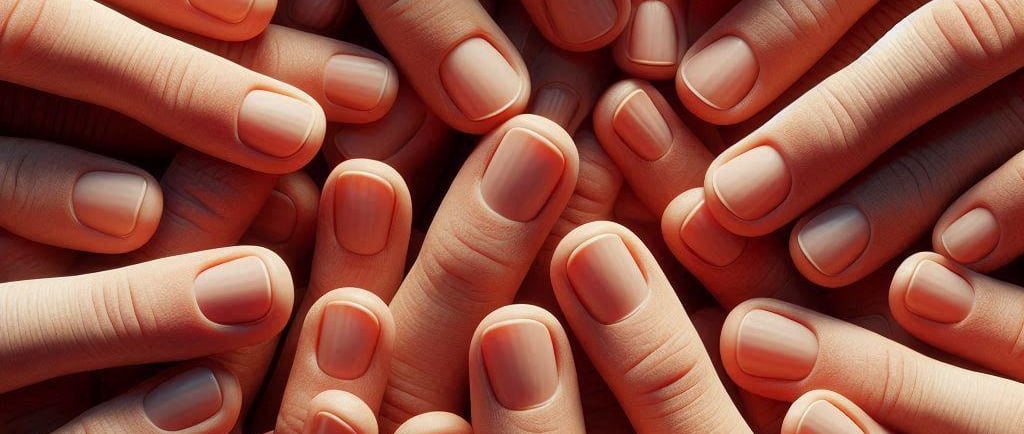Fingernails: Your Health's Secret Indicator
HEALTH


```html
Introduction to Fingernails and Health
Fingernails, the thin plates of keratin that shield our fingertips, are more than just cosmetic features. They serve as vital indicators of our overall health. Composed primarily of laminated layers of a protein called keratin, fingernails grow from the area at the base of the nail under your cuticle. As new cells grow, older cells become hard and compacted, eventually forming the visible fingernail.
Given their composition and growth pattern, fingernails can offer a window into our body's internal workings. Changes in color, texture, shape, and thickness can signal a variety of health issues, ranging from nutrient deficiencies to more serious conditions like cardiovascular diseases or diabetes. For instance, pale or whitish nails may indicate anemia, while yellowish nails can be a sign of respiratory issues or fungal infections.
Understanding the link between fingernails and health requires a basic knowledge of their structure. The nail matrix, located beneath the cuticle, is responsible for producing new nail cells. A disruption in the matrix due to illness or nutritional deficiency can manifest as visible changes in the nails. Similarly, the nail bed—the skin beneath the nail plate—can reflect circulatory and oxygenation issues, often seen through discoloration or changes in nail growth patterns.
In summary, fingernails provide a crucial, yet often overlooked, insight into our health. By paying attention to the subtle changes in our nails, we can catch early signs of potential health problems, allowing for timely intervention and treatment. This blog post aims to delve deeper into the various signs and symptoms that our fingernails can reveal, helping readers to become more attuned to these often-ignored health indicators.
Common Nail Changes and What They Mean
Fingernails can serve as a window into your overall health, revealing potential issues through various changes in their appearance. Common alterations in color, texture, and growth patterns can often signal underlying health concerns. Recognizing these signs can prompt timely medical consultations and interventions.
One frequent change is discoloration. Healthy nails are typically pink with a white crescent (lunula) at the base. Yellow nails may indicate a fungal infection or conditions such as psoriasis or thyroid disease. Blue nails can be a sign of a lack of oxygen in the blood, often related to respiratory issues or cardiovascular problems. White spots, though commonly associated with minor trauma, can also signal zinc deficiency.
Texture changes are another key indicator. Brittle, split, or cracked nails can be symptomatic of nutritional deficiencies, particularly in vitamins and minerals like iron, biotin, and vitamin C. Onychorrhexis, the medical term for longitudinal ridging, can suggest anemia or hypothyroidism. Conversely, spoon-shaped nails (koilonychia) often point to iron-deficiency anemia.
Nail growth patterns also hold valuable clues. Nails that grow slower than normal can be associated with nutritional deficits or systemic diseases, such as chronic renal failure. Conversely, rapidly growing nails might indicate hyperthyroidism. Beau's lines, or horizontal grooves across the nails, can result from severe illness, malnutrition, or direct trauma to the nail matrix.
Moreover, changes in the nail’s proximal fold or cuticle can be telling. Redness and swelling around the nail bed might indicate an infection or inflammatory condition such as lupus or psoriasis. Pitting, or small depressions on the nail surface, is often linked to psoriasis or alopecia areata.
Monitoring these variations can be pivotal for early detection of health issues. While not all changes warrant immediate concern, persistent or significant alterations should prompt a consultation with a healthcare provider to rule out or manage underlying conditions.
Nail Disorders: Symptoms and Causes
Nail disorders can often be the first visible sign of underlying health issues. Among the most common nail disorders are fungal infections, psoriasis, and onycholysis. Each of these conditions presents with distinct symptoms and originates from various causes, making early identification crucial for effective treatment and management.
Fungal infections, or onychomycosis, are prevalent and typically characterized by discolored, thickened, and brittle nails. The fungal infection usually starts at the edge of the nail and gradually spreads, leading to changes in nail texture and appearance. The primary cause of onychomycosis is dermatophytes, a type of fungus that thrives in warm, moist environments. Diagnosis often involves a physical examination and may require laboratory tests to identify the specific type of fungus.
Psoriasis, an autoimmune condition, can also manifest in the nails. Nail psoriasis is marked by pitting, discoloration, and the separation of the nail from the nail bed, known as onycholysis. The exact cause of nail psoriasis is not entirely understood, but it is linked to an overactive immune response that accelerates the production of skin cells. Diagnosis is usually based on the presence of both skin and nail symptoms, supported by a patient's medical history.
Onycholysis, the detachment of the nail from the nail bed, can occur due to various reasons, including trauma, infection, or underlying systemic conditions such as thyroid disorders. Symptoms often include a white or yellowish discoloration where the nail has lifted, and it can be accompanied by pain or tenderness. Identifying the root cause of onycholysis is essential for effective treatment, which may involve addressing the underlying health issue or avoiding contact with irritants.
Understanding the symptoms and causes of these common nail disorders is vital for early diagnosis and treatment. By recognizing changes in your nails, you can take proactive steps to address potential health problems and maintain overall well-being.
The Connection Between Nail Health and Nutritional Status
Nail health is intricately linked to one's nutritional status, with several essential vitamins and minerals playing a critical role in maintaining strong and healthy nails. One of the most significant nutrients for nail health is biotin, a water-soluble B-vitamin that supports the production of keratin, the protein that makes up the nails. Biotin deficiency can lead to brittle nails and slower nail growth. To ensure adequate biotin intake, include foods like eggs, nuts, seeds, and sweet potatoes in your diet.
Iron is another vital mineral for nail health. Iron deficiency, commonly known as anemia, can cause nails to become thin, brittle, and concave, a condition known as koilonychia. Incorporating iron-rich foods, such as lean meats, spinach, lentils, and fortified cereals, can help maintain optimal iron levels and prevent these nail abnormalities.
Zinc, a crucial trace element, plays a pivotal role in cell growth and repair, including the cells that make up the nails. A lack of zinc can result in white spots on the nails and other structural weaknesses. To boost zinc intake, consider consuming foods like oysters, beef, pumpkin seeds, and chickpeas.
In addition to these nutrients, a balanced diet that includes a variety of vegetables, fruits, whole grains, and lean proteins is essential for overall nail health. Hydration is also key, as dry nails are more prone to breakage. Drinking plenty of water and consuming hydrating foods such as cucumbers and watermelon can help keep nails strong and resilient.
By focusing on a nutrient-rich diet and ensuring adequate intake of biotin, iron, and zinc, individuals can support healthy nail growth and strength. Nutritional status is a powerful indicator of nail health, and maintaining a well-rounded diet is fundamental to preserving the integrity and appearance of fingernails.
When to Seek Professional Help
Recognizing when to seek professional help for changes in your fingernails is crucial for maintaining overall health. While some nail changes are benign and can be attributed to minor issues, others may indicate more serious underlying conditions. Understanding the warning signs that necessitate professional consultation can aid in early detection and intervention, potentially preventing more severe health complications.
One of the primary indicators to watch for is significant color changes in your nails. If you notice your nails turning yellow, green, blue, or black, it is advisable to consult a healthcare professional. Such discoloration can be a sign of fungal infections, bacterial infections, or even systemic conditions like diabetes or cardiovascular disease. Additionally, sudden changes in nail texture, such as pitting, ridges, or crumbling, warrant a professional evaluation as they may be linked to conditions like psoriasis or eczema.
Another critical sign is the appearance of lines or grooves on your nails. Horizontal lines, also known as Beau's lines, can indicate a temporary halt in nail growth due to severe illness, malnutrition, or chemotherapy. On the other hand, vertical ridges are often a normal part of aging but can sometimes signal conditions such as rheumatoid arthritis. If you observe these changes, especially if accompanied by other symptoms like joint pain or fatigue, it is essential to seek medical advice.
Moreover, changes in nail thickness and shape should not be ignored. Nails that become unusually thick, thin, or clubbed (where the ends of your fingers swell and your nails curve around them) can point to respiratory issues, heart disease, or thyroid problems. Pain, swelling, or bleeding around the nails are also red flags that necessitate professional attention.
Preparing for a medical consultation involves noting all observed changes in your nails, any accompanying symptoms, and any recent health changes or treatments. Providing your healthcare provider with a detailed history can facilitate accurate diagnosis and appropriate treatment. Early detection and timely intervention are key in addressing potential health issues, underscoring the importance of paying attention to your fingernails as indicators of your overall health.
Tips for Maintaining Healthy Nails
Maintaining healthy nails requires a combination of proper care routines, avoiding detrimental habits, and understanding the benefits of regular manicures. Here are some practical tips to help keep your nails in optimal condition.
First and foremost, establish a consistent nail care routine. Clean your nails regularly and be sure to keep them dry. Excess moisture can lead to the growth of bacteria and fungi, which can cause infections. Use a gentle nail brush to clean beneath the nails and a quality nail file to keep them well-shaped and smooth.
Moisturizing is also crucial for nail health. Apply a hydrating hand cream that contains ingredients like shea butter or glycerin to keep both your nails and cuticles hydrated. This can prevent nails from becoming brittle and breaking. Additionally, cuticle oil can nourish the nail bed and promote healthy nail growth.
Avoid harmful habits such as nail biting and using your nails as tools. Biting nails can introduce bacteria and damage the nail bed, leading to potential infections. Using your nails to open packages or scrape surfaces can cause them to break or split. Instead, use appropriate tools to perform these tasks.
Incorporate regular manicures into your nail care regimen. Professional manicures not only keep your nails looking their best but also help maintain their health. During a manicure, cuticles are pushed back and trimmed, and nails are filed and polished. Opt for non-toxic nail polishes and removers to minimize exposure to harmful chemicals.
Finally, pay attention to your diet, as it plays a significant role in nail health. Consuming a balanced diet rich in vitamins and minerals such as biotin, vitamin E, and zinc can support strong and healthy nails. Consider taking supplements if you find it challenging to meet your nutritional needs through food alone.
By following these tips and making nail care a regular part of your routine, you can ensure that your nails remain healthy, strong, and attractive. Remember, your nails are a reflection of your overall health, so taking good care of them is essential.
